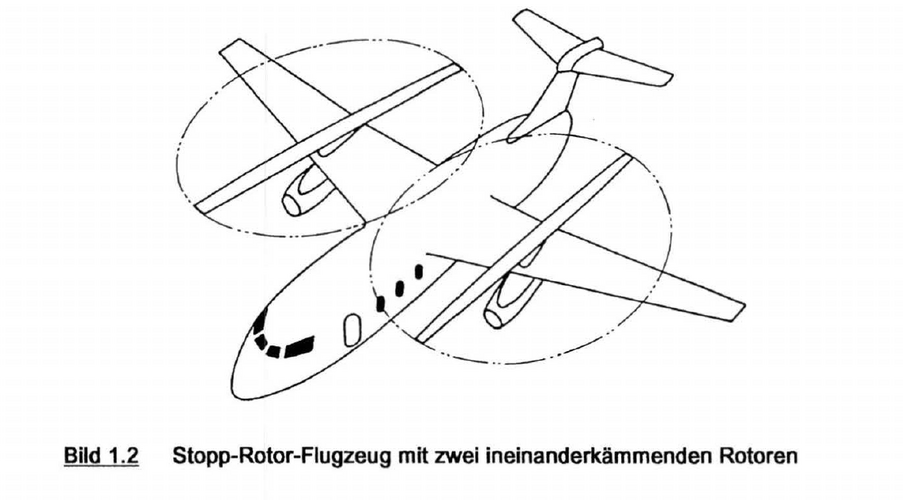Messerschmitts Projekt Me 408
Mit 700 km/h von Haus zu Haus
Es sollte kein Wunschtraum mehr bleiben, mit 700 km/h von Haus zu Haus zu fliegen. Professor Willy Messerschmitt projektierte Mitte der 60er Jahre den "Roto-Jet" Me 408, der wirtschaftlicher als alle anderen Senkrechtstarter-Konzepte und schneller als jeder Hubschrauber fliegen sollte.
Das neue Messerschmitt-Projekt trug die Bezeichnung Me P. 408 Rotor-Jet und war als sechssitziges Geschäftsreise- und Verbindungsflugzeug ausgelegt. Die große Neuerung des Ganzmetall-Hochdeckers waren zwei Hubrotoren an den Flügelenden, die das ganze Flugzeug wie einen Hubschrauber senkrecht in die Luft heben und ebenso zur senkrechten Landung zu Boden bringen können. Hatte das Flugzeug vom Boden abgehoben, sollte es zunächst wie ein Hubschrauber auf Kurs gehen. Bei Erreichen einer bestimmten Geschwindigkeit sollten die bis dahin über Fernwellen vom Triebwerk angetriebenen Rotoren vom Antrieb abgekoppelt werden, um dann mit positivem Anstellwinkel in einem „Tragschraubermodus“ weiter Auftrieb zu erzeugen. Im Reiseflug sollte der „Rotor-Jet“ dann ganz auf den Auftrieb durch die Rotoren verzichten können und als normaler Jet mit einer Geschwindigkeit bis zu 750 km/h weiterfliegen. Um den schädlichen Luftwiderstand der Rotoren auszuschalten, sollten diese nach dem Übergang in den Reiseflug sich zusammenfalten und in zwei Außenbehältern an den Flügelenden, die gleichzeitig als Treibstofftanks dienen sollten, einfahren. Nun hatte das neue Messerschmitt-Flugzeug ganz das Aussehen jedes normalen Jets und sollte auch dessen hohe Reisegeschwindigkeiten erreichen.
Zur senkrechten Landung sollten bei verminderter Geschwindigkeit die Rotorblätter aus ihren Behältern ausfahren, das Flugzeug sich im Übergang zum Langsamflug wieder zu einem Hubschrauber verwandeln und wie ein solcher senkrecht auf kleinstem Raum landen.
Zwei Strahltriebwerke, halb in die hinteren Rumpfseiten eingelassen, sollten zum Antrieb der Rotoren und zum Vortrieb während des Schnellfluges dienen. Die beiden Hubrotoren waren gegenläufig, so dass ein Heckrotor unnötig war. Die Transitionsendgeschwindigkeit, also die Geschwindigkeit, bei der die Rotoren voll eingefahren werden können, sollte bei 250 km/h liegen.
Als Vorteile eines solchen Flugzeugtyps, den Messerschmitt „Rotor-Jet“ nannte, versprach man sich gegenüber bisherigen Senkrechststartern mehr Wirtschaftlichkeit, kaum ungünstiger als bei konventionellen Flugzeugen, vor allem, wenn man den absoluten Zeitgewinn und die Ersparnis teuerer Startbahnen berücksichtigte. Und der „Rotor-Jet“ sollte sicherer als alle anderen Flugzeuge sein, da er auch im Falle des gesamten Triebwerksausfalls im Autorotationsflug sicher und sanft zur Erde gebracht werden könne, argumentierte ein Messerschmitt-Papier.
Der Anwendungsbereich eines „Rotor-Jets“ sei auf dem zivilen Luftfahrtsektor nahezu unbegrenzt, auf dem militärischen mit den Verwendungsmöglichkeiten als Verbindungs-, Beobachtungs-, Ambulanz- und Trainingsflugzeug hochinteressant. Es bestehe kein Zweifel, dass ein weites Gebiet des zivilen Luftverkehrs von „Rotor-Jets“ geradezu revolutioniert werden könne, hieß es weiter. Ohne besondere Zufahrtstraßen, ohne aufwendige Flugplatzanlagen und nicht zuletzt ohne zeitraubende Zubringerzeiten könne jeder Verkehr von Stadt zu Stadt durchgeführt werden. Das diese Möglichkeiten auch für die Wirtschaft eine große Bedeutung haben würden, bedürfe keiner besonderen Erklärung.
Professor Messerschmitt, der unter anderem bereits mit der Konstruktion des ersten in Großserie gebauten Strahljägers der Welt, der Me 262, eine neue Aera in der Luftfahrt wegweisend eingeleitet hatte, hatte die Vision, dass das neue „Rotor-Jet“-Projekt in wenigen Jahren zu realisieren wäre, wenn die nötigen Mittel zur Verfügung stünden. Die deutsche Luftfahrtentwicklung, die bereits in der Konstruktion von Senkrechtstartern einen führenden Platz einnähme, könne sich dann auch im Bau von Rotor-Jets eine erste Position erarbeiten, die international von ungewöhnlicher Bedeutung wäre.
Auch in anderen Ländern, vor allem in den USA, beschäftigte sich schon damals die Luftfahrtindustrie mit ähnlichen Projekten. Es würde zweifellos auf diesem Gebiet zu einem internationalen Wettbewerb kommen, hieß es damals. Die deutsche Luftfahrt habe sehr gute Aussichten, wenn ihr denn die Mittel zur Verfügung gestellt würden, rechtzeitig und mit allen Kräften den „Rotor-Jet“ weiter zu entwickeln. Wie man heute weiß, kam es dazu aber nicht.
 ;D
;D 























































